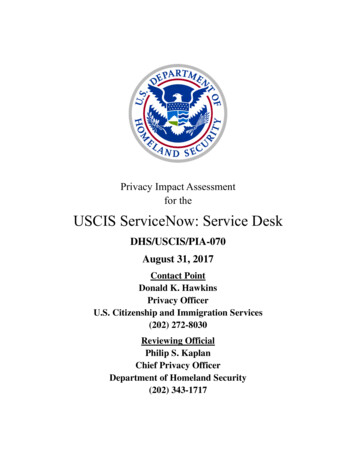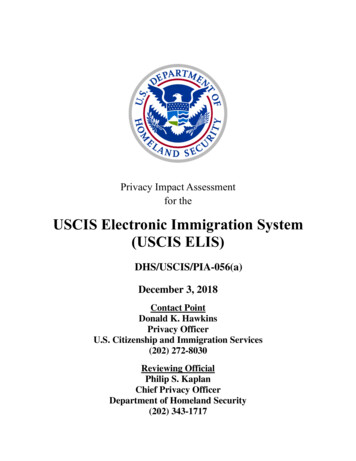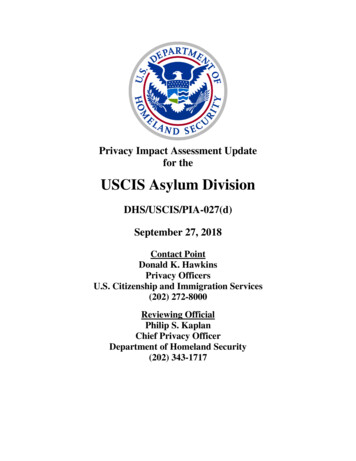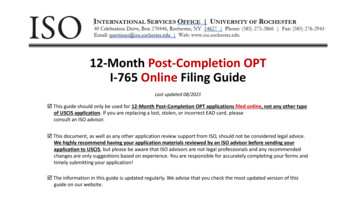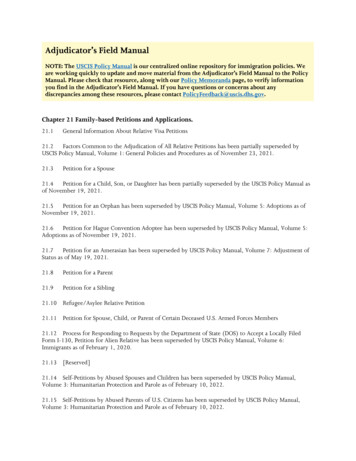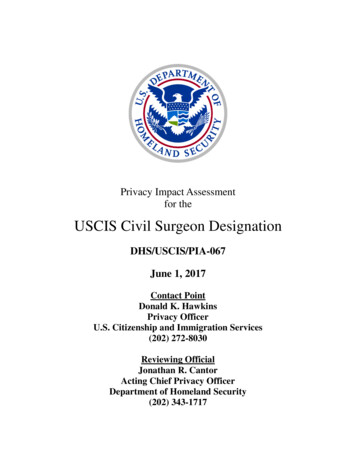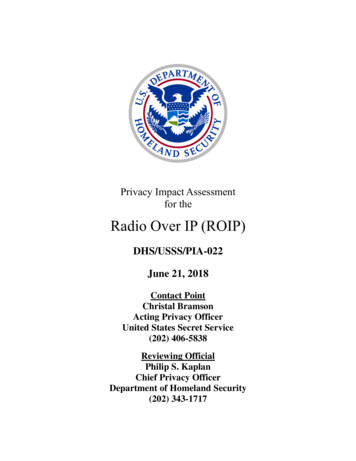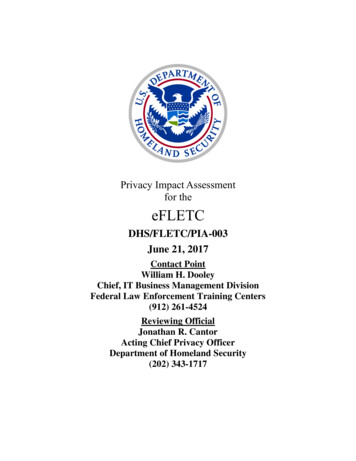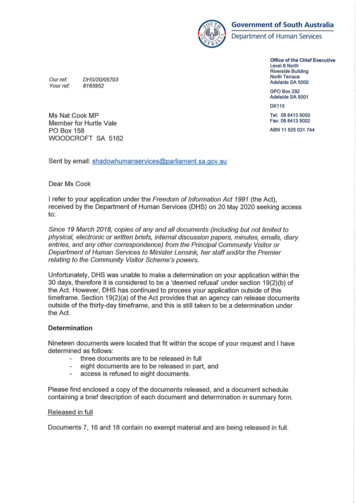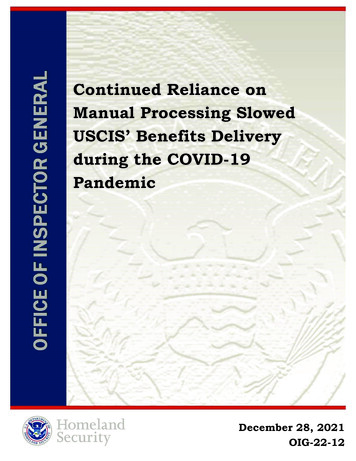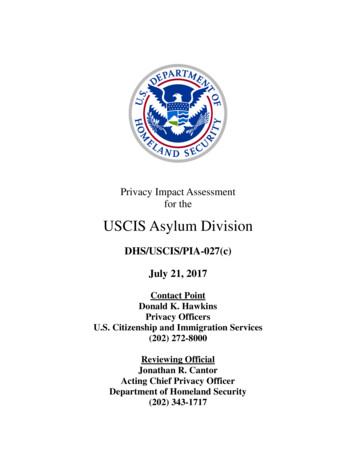
Transcription
Privacy Impact Assessmentfor theUSCIS Asylum DivisionDHS/USCIS/PIA-027(c)July 21, 2017Contact PointDonald K. HawkinsPrivacy OfficersU.S. Citizenship and Immigration Services(202) 272-8000Reviewing OfficialJonathan R. CantorActing Chief Privacy OfficerDepartment of Homeland Security(202) 343-1717
Privacy Impact AssessmentDHS/USCIS/PIA-027(c) USCIS Asylum DivisionPage 1AbstractThe Asylum Division of the U.S. Citizenship and Immigration Services (USCIS)adjudicates applications for asylum, benefits pursuant to Section 203 of the NicaraguanAdjustment and Central American Relief Act (NACARA § 203), withholding of removal underthe terms of a settlement agreement reached in a class action 1, and screening determinations forsafe third country, credible fear, and reasonable fear. The Asylum Division maintains theRefugees, Asylum, and Parole System (RAPS) and the Asylum Pre-Screening System (APSS).Both systems, originally developed by the former Immigration and Naturalization Service (INS),are used by the USCIS Asylum Division 2 to capture information pertaining to asylum applications,credible fear and reasonable fear screening processes, and applications for benefits provided bySection 203 of the Nicaraguan Adjustment and Central American Relief Act (NACARA § 203). 3USCIS is updating and reissuing this Privacy Impact Assessment (PIA) because the AsylumDivision manages records and systems containing personally identifiable information (PII) in orderto conduct its adjudications.OverviewU.S. Citizenship and Immigration Services (USCIS) is the component of the Departmentof Homeland Security (DHS) that oversees lawful immigration to the United States. As set forthin Section 451(b) of the Homeland Security Act of 2002, Public Law 107-296, Congress chargedUSCIS with administering the asylum program. USCIS, through its Asylum Division, administersthe affirmative asylum program to provide protection to qualified individuals in the United Stateswho have suffered past persecution or have a well-founded fear of future persecution in theircountry of origin, as outlined under Section 208 of the Immigration and Nationality Act (INA), 8U.S.C. § 1158 and 8 CFR § 208. The USCIS Asylum Division also adjudicates the benefit programestablished by the Nicaraguan Adjustment and Central American Relief Act (NACARA) § 203and administers safe third country, credible fear, and reasonable fear screening processes. 4 ThisPrivacy Impact Assessment examines the USCIS Asylum Division program, the information thatit collects, as well as its case management systems and support information technology systems.The Asylum Division supports the following four programs:1American Baptist Churches v. Thornburgh, 760 F. Supp. 796 (N.D. Cal. 1991) (ABC Settlement).Despite its name, no refugee or parole applicant records are stored in RAPS. Although those immigrationclassifications were contemplated as part of RAPS’s original design, they were never included operationally.3Pub. L. No. 105-100, 111 Stat. 2193 (1997), amended by Pub. L. No. 105-139, 111 Stat. 2644 (December 2, 1997).4Section 203 of Pub. L. No. 105-100.2
Privacy Impact AssessmentDHS/USCIS/PIA-027(c) USCIS Asylum DivisionPage 21) Affirmative Asylum 5Foreign nationals may seek protection through asylum if they suffered persecution or fearthat they will suffer persecution on account of race, religion, nationality, membership in aparticular social group, or political opinion. To obtain asylum, the individual must be physicallypresent in the United States. There are two ways to apply for asylum in the United States: throughthe affirmative asylum process and the defensive asylum process.The Asylum Division is responsible for the administration of the affirmative asylumprocess and adjudication of the affirmative asylum application. An individual not in removalproceedings may apply for asylum through the affirmative asylum process regardless of how he orshe arrived in the United States or his or her current immigration status by filing Form I-589,Application for Asylum and for Withholding of Removal, 6 with USCIS. An individual may alsofile Form I-589 as a defensive application in removal proceedings before an Immigration Judge ofthe Department of Justice’s (DOJ) Executive Office for Immigration Review (EOIR). 7An asylum applicant may include in the application his or her spouse and any children asdependent asylum applicants if they are in the United States, comply with the requirements ofproviding biometrics, and appear at the asylum interview.,8 A grant of asylum to the principalasylum applicant is the basis for a grant of asylum to the spouse and any children included asdependent applicants as long as the spouse or child is in the United States and not otherwise barredfrom a grant of asylum. Additionally, Form I-589 requests information on each applicant’s parents,siblings, former spouses, and children, regardless of whether they are included as dependentapplicants.2) Nicaraguan Adjustment and Central American Relief Act (NACARA Section 203) 9NACARA § 203 allows individuals who meet certain criteria, along with qualifying familymembers, to apply for suspension of deportation or for special rule cancellation of removal under5See INA § 208; see also 8 CFR § 208, describing the asylum process.Witholding of Removal must be granted when the evidence establishes that it is more likely than not that theapplicant’s life or freedom is threatened of account of race, religion, nationality, membership in a particular socialgroup, or political opinion in the proposed country of removal.7Immigration Judges are adjudicators within the Department of Justice’s Executive Office for Immigration Review(EOIR). Persons whose removal is being sought by DHS generally appear before an Immigration Judge who willadjudicate any benefit or protection for which the foreign national may be eligible, including asylum and withholdingof removal.8Children under the age of 14 are not required to provide a signature on an application, petition, or request filedwith USCIS, but they may choose to sign their name during their ASC appointment if they are capable of signing. Aparent or legal guardian may also sign the application, petition, or request on the child’s behalf.9NACARA § 203 applies to certain individuals from Guatemala, El Salvador, and the former Soviet bloc countries(the Soviet Union or any republic of the former Soviet Union, such as Russia, Latvia, Lithuania, Estonia, Albania,Bulgaria, the former Czechoslovakia, the former East Germany, Hungary, Poland, Romania, or Yugoslavia or anystate of the former Yugoslavia) who entered the United States and applied for asylum by specified dates or registeredfor benefits as well as certain of their relatives. See 8 CFR §§ 240.60 - 204.70.6
Privacy Impact AssessmentDHS/USCIS/PIA-027(c) USCIS Asylum DivisionPage 3the standards for suspension of deportation similar to those in effect before the Illegal ImmigrationReform and Immigrant Responsibility Act of 1996 (IIRIRA). 10 Form I-881, Application forSuspension of Deportation or Special Rule Cancellation of Removal is used to apply for benefitsunder NACARA § 203.Form I-881 solicits biographic information about the applicant; their presence in the UnitedStates; entries and departures; the applicant’s financial status and employment; information aboutthe applicant’s current spouse, former spouses, children, and parents; information relating to theeligibility criteria for benefits under NACARA § 203; 11 and information about the Form I-881preparer, if prepared by someone other than the applicant. Applicants must also comply with therequirements of providing biometrics.3) Credible Fear Screenings 12Individuals subject to expedited removal who indicate an intention to apply for asylum,express a fear of persecution or torture, or a fear of return to their home country are referred toUSCIS Asylum Officers to determine whether they have a credible fear of persecution or torture.Individuals found to have a credible fear of persecution or torture are placed in removalproceedings under INA § 240 and may apply for asylum or withholding of removal as a defenseto removal before an Immigration Judge by filing Form I-589, or pursue other forms of relief orprotection from removal. The Asylum Division electronically receives information about crediblefear applicants through referral documentation provided by U.S. Immigration and CustomsEnforcement (ICE) or U.S. Customs and Border Protection (CBP). The referral documentationincludes forms containing information about the applicant: Form I-860, Notice and Order ofExpedited Removal, and Form I-867, A&B, Record of Statement in Proceedings under Section235(b)(1) of the Act & Jurat for Record of Sworn Statement in Proceedings under Section235(b)(1) of the Act.As part of the credible fear screening adjudication, Asylum Officers prepare Form I-870,Record of Determination/Credible Fear Worksheet. This worksheet includes biographicinformation about the applicant, including the applicant’s name, date of birth, gender, country of10See Pub. L. 104-208.Form I-881 solicits information used to determine whether the applicant can demonstrate good moral character forthe seven years prior to filing the application, and whether the applicant or his or her United States Citizen or lawfulpermanent resident spouse, parent, or child will suffer extreme hardship if the applicant is removed from the UnitedStates. See 8 CFR §§ 240.60 - 240.70.12Section 235 of the INA, as amended, and its implementing regulations provide that certain categories of individualsare subject to expedited removal without a hearing before an Immigration Judge. These include: arriving stowaways;certain arriving aliens at ports of entry who are inadmissible under section 212(a)(6)(C) of the INA (because they havepresented fraudulent documents or made a false claim to U.S. citizenship or other material misrepresentations to gainadmission or other immigration benefits) or 212(a)(7) of the INA (because they lack proper documents to gainadmission); and certain designated aliens who have not been admitted or paroled into the United States and who areinadmissible under INA 212(a)(6)(C) or (7). See also 8 C.F.R. § 235.3 and 8 C.F.R. § 208.30.11
Privacy Impact AssessmentDHS/USCIS/PIA-027(c) USCIS Asylum DivisionPage 4birth, nationality, ethnicity, religion, language, and information about the applicant’s entry into theUnited States and place of detention. Additionally, Form I-870 collects sufficient informationabout the applicant’s marital status, spouse, and children to determine whether they may beincluded in the determination. Form I-870 also documents the interpreter ID number of theinterpreter used during the credible fear interview and collects information about a relative orsponsor in the United States, including their relationship to the applicant and contact information.4) Reasonable Fear Screenings 13Sections 238(b) and 241(a)(5) of the INA provide for streamlined removal procedures thatprohibit certain individuals subject to a final administrative removal order under section 238(b) orwhose prior order of exclusion, deportation, or removal is reinstated under section 241(a)(5) of theINA, from contesting removability before an Immigration Judge and from seeking any relief fromremoval. If an individual ordered removed under either section 238(b) or section 241(a)(5) of theINA expresses a fear of return to the country to which he or she has been ordered removed, thecase must be referred to a USCIS Asylum Officer to determine whether the individual has areasonable fear of persecution or torture. Individuals found to have a reasonable fear of persecutionor torture are referred to an Immigration Judge for withholding-only proceedings in which theymay seek withholding of removal under INA § 241(b)(3), or withholding or deferral of removalunder regulations implementing U.S. obligations under the Convention Against Torture by filingForm I-589. The referral documentation that USCIS receives from ICE with information about theapplicant includes either a fully executed Form I-851A, Final Administrative Removal Order; ora fully executed Form I-871, Notice of Intent/Decision to Reinstate Prior Order and a copy of theprior order of removal.As part of the reasonable fear screening process, USCIS Asylum Officers prepare Form I899, Record of Determination/Reasonable Fear Worksheet. This worksheet includes biographicinformation about the applicant, including the applicant’s name, date of birth, gender, country ofbirth, nationality, ethnicity, religion, language, and information about the applicant’s entry into theUnited States and place of detention. Form I-899 also documents the interpreter ID number of theinterpreter used during the reasonable fear interview.Information Technology (IT) and Support SystemsThe USCIS Asylum Division is primarily served by two information technology datasystems:1) Refugees, Asylum, and Parole System (RAPS) is a comprehensive case management toolthat enables USCIS to handle and process applications for asylum pursuant to Section 20813See 8 C.F.R. §§ 238.1, 241.8, 208.31.
Privacy Impact AssessmentDHS/USCIS/PIA-027(c) USCIS Asylum DivisionPage 5of the INA and applications for suspension of deportation or special rule cancellation ofremoval pursuant to NACARA § 203.Private Attorney Maintenance System (PAMS) is a subsystem RAPS. It maintains data onapplicants’ attorneys such as name, firm, and address. Each attorney is identified by anidentification code, consisting of the office code and a sequential number. PAMS links toRAPS and stores attorney's address information.2) Asylum Pre-Screening System (APSS) is a case management system that supportsUSCIS in the screening of individuals in the credible fear and reasonable fear processes.These systems are used to capture information pertaining to asylum applications, credible fear andreasonable fear screening processes, and applications for benefits provided by NACARA § 203.The USCIS Asylum Division uses RAPS and APSS to track case status and facilitate thescheduling of appointments and interviews, and the issuance of notices (including receipt notices,interview appointment notices, and decision letters) at several stages of the adjudication process.The systems also initiate, receive, and record responses for national security and background checkscreening and prevent the approval of any benefit prior to the review and completion of all securitychecks. Finally, the systems provide a means for analyzing and managing program workflows andprovide the Asylum Program with statistical reports to assist with oversight of production andprocessing goals.In addition to RAPS and APSS, the USCIS Asylum Division also uses SharePoint,14referred to as Enterprise Collaboration Network (ECN), 15 and locally-developed applications(LDA) 16 to support its mission and day-to-day functions. Asylum Division information may behosted on internal ECN networks and LDAs. The Asylum Division ECN site and LDAs provide asecure environment to facilitate collaboration among Asylum Division personnel across its fieldoffices and headquarters. The appendices to this PIA delineate USCIS Asylum Division’s use ofECN and LDAs for the processing of asylum applications, NACARA § 203 applications, andcredible fear and reasonable fear screenings. RAPS or APSS information, including Sensitive PII,that may otherwise have been stored on a shared drive or transmitted via email may be hosted oninternal SharePoint/ECN networks in order to reduce dependency on those tools and minimizeassociated costs and technical limitations.14SharePoint is a commercial off-the-shelf (COTS) web-based application that provides a platform on which tobuild custom applications and features a suite of collaboration, document management, and communication tools, aswell as a high degree of integration with other Microsoft Office products.15The Asylum Division SharePoint environment provides offices the ability to quickly and electronically meet theirbusiness needs through the use of document, workflow, form, and records management as well as reporting,auditing, and organizational capabilities.16A LDA is an application that stores, processes, or transmits USCIS data, but is not currently recognized as anofficial USCIS system within the USCIS IT inventory, and has not been brought into FISMA compliance to meetDHS IT Security policies.
Privacy Impact AssessmentDHS/USCIS/PIA-027(c) USCIS Asylum DivisionPage 6The Asylum Division’s use of SharePoint/ECN is consistent with the Privacy ImpactAssessment for DHS Employee Collaboration Tools. 17 The Asylum Division SharePoint/ECN sitecollection provides a secure environment to facilitate collaboration among Asylum Divisionpersonnel across its field offices and headquarters. Information in the SharePoint/ECN sitecollection is protected using security safeguards established by DHS. Asylum Division SharePointsites have designated facilitators responsible for determining user access and ensuring that the sitesare only used for approved purposes, such as internal collaboration, document hosting, andworkflow management. These facilitators receive special training and actively managepermissions to ensure that only users with a need-to-know have access to information on theAsylum SharePoint/ECN sites. The Asylum Division SharePoint site collection designates pagesapproved to host sensitive PII with a “Sensitive Personally Identifiable Information Allowed”banner at the top of each page.Refugee, Asylum, and Parole System (RAPS)RAPS is a comprehensive case management tool that enables USCIS to handle and processapplications for asylum and applications for suspension of deportation or special rule cancellationof removal pursuant to NACARA § 203. USCIS, ICE, and CBP offices worldwide can accessRAPS data through the Person Centric Query System (PCQS) as a resource of current and historicimmigration status information on more than one million applicants. 18 DHS officials can useRAPS to verify the status of asylum applicants, asylees (individuals granted asylum), and theirderivatives to assist with the verification of an individual’s immigration history in the course of areview of visa petitions and other benefit applications as well.Preliminary Processing of Application:As described in the Benefit Request Intake Process PIA, 19 an asylum or NACARA § 203accredited representative 20 or legal representative 21 (hereafter collectively referred to as legalrepresentative) submits an application and supporting documentation to USCIS. Asylumapplicants file Form I-589, Application for Asylum and for Withholding of Removal, with a USCISService Center, or in certain circumstances directly with an Asylum Office. NACARA § 203applicants file Form I-881, The Application for Suspension of Deportation or Special RuleCancellation of Removal. Service Center or Asylum personnel receive the application by mail andmanually enter most of the information from a new application into RAPS.17See DHS/ALL/PIA-059 Employee Collaboration Tools, available at www.dhs.gov/privacy.See DHS/USCIS/PIA-010 Person Centric Query Service, available at www.dhs.gov/privacy.19See DHS/USCIS/PIA-061 Benefit Request Intake Process, available at www.dhs.gov/privacy.20A person who is approved by the Board of Immigration Appeals (the Board or BIA) to represent aliens before theImmigration Courts and USCIS. The organization must be authorized by the Board to represent aliens.21An attorney or a BIA-accredited representative can represent a benefit requestor before USCIS, as a legalrepresentative with an approved G-28, Notice of Entry of Appearance as Attorney or Accredited Representative onfile.18
Privacy Impact AssessmentDHS/USCIS/PIA-027(c) USCIS Asylum DivisionPage 7The Form I-589 and Form I-881 collect biographic and demographic information about theapplicant, including the applicant’s full name, Alien Number (A-Number), Social Security number(SSN), gender, marital status, religious affiliations, nationality, ethnicity, race, hair and eye color,and weight, as well as travel, educational, residential, and employment history. Similar biographicinformation is collected for any dependent spouse or children who are included on the application.These applications allow the applicant to present details of his or her substantive claim for therequested benefit and to supplement his or her application with additional documentary evidencerelevant to his or her claim.Rather than redundantly storing data on attorneys representing asylum applicants, RAPSlinks to the Private Attorney Maintenance System (PAMS) and stores only the attorney ID, a valuethat uniquely identifies the attorney. PAMS contains data on benefit requestor’s attorneys such asname, firm, and address. Each attorney is identified by an identification code, consisting of theoffice code and a sequential number. USCIS uses the attorney ID in RAPS to retrieve attorney datafrom PAMS, such as name and contact information, for purposes of display in RAPS and forcreating attorney copies of all correspondence with the applicant.When a new case is created in RAPS, the system electronically sends A-Numbers to theCentral Index System (CIS) to either create a record or update an existing record. 22 The purposeof CIS is to provide a searchable central index of A-Files as needed in support of immigrationbenefit and enforcement actions. CIS returns records associated with an A-Number used toascertain an individual’s current and prior immigration status.RAPS also interfaces with the National File Tracking System (NFTS), which is anautomated file-tracking system used to maintain an accurate file inventory and track the physicallocation of A-Files, 23 to share file location information, and to electronically input the A-Numberand File Control Office (FCO) into NFTS. 24 When a user requires the A-File, the user goes to CISand requests the file. CIS has a direct interface with NFTS to request the file. NFTS maintains andcontrols the inventory of all A-Files, queries the file location, and manages the request and transferof A-Files between Asylum Offices and FCOs.Background, Identity, and Security ChecksAsylum and NACARA § 203 applicants are subject to background, identity, and securitychecks to ensure eligibility for the requested benefit and to ensure that they do not pose a threat topublic safety or the national security of the United States. USCIS conducts background, identity,and security checks as part of regular case processing.22See DHS/USCIS/PIA-009 Central Index System (CIS), available at www.dhs.gov/privacy.NFTS does not store a digitized copy or the entire content of the immigration files.24See DHS/USCIS/PIA-032 National File Tracking System (NFTS), available at www.dhs.gov/privacy.23
Privacy Impact AssessmentDHS/USCIS/PIA-027(c) USCIS Asylum DivisionPage 8Once the information in the I-589 is entered into RAPS, USCIS generates an appointmentnotice for the collection of biometrics. The Asylum Division uses the National AppointmentScheduling System (NASS) to schedule appointments for fingerprinting at a USCIS ApplicationSupport Center (ASC). USCIS personnel may schedule NASS appointments automatically ormanually. 25 NASS may automatically generate appointments through an interface with RAPS.USCIS personnel may manually expedite such a process by requesting an appointment for certainbenefit requestors directly in NASS.Applicants are required to appear at an ASC to be fingerprinted and have their photographtaken. USCIS electronically captures the applicant’s fingerprints, photograph, and relatedbiographic data required to verify the individual’s identity and to ensure that the correct biographicinformation is associated with the captured biometrics. Biometric data is captured in CustomerProfile Management System (CPMS), which is the centralized source of biometric images usedfor USCIS benefit card and document production. 26 Biometric and biographic data are also sent tothe print production systems for employment authorization documents. Once biometrics arecollected, they are submitted for enrollment in DHS’s Automated Biometric Identification System(IDENT) 27 for vetting against the Department of Defense (DoD) Automated BiometricInformation System (ABIS), 28 and to the Federal Bureau of Investigation (FBI) for vetting againstthe Next Generation Information (NGI) system. 29 The results from CPMS are uploaded into RAPS.RAPS also automatically initiates several background, identity, and security checks,querying records held by DHS (e.g., ICE ENFORCE Alien Removal Module (EARM)), the FBI(including FBI name check 30) and the National Counterterrorism Center (NCTC). RAPS receivesand stores the results of these automatically initiated checks. In addition to automatically initiatedchecks, asylum data may be used for additional background, identity, and security checks duringthe process of vetting a case for adjudication. These may include the use of classified systems,social media checks, analysis by the CBP National Targeting Center, or other forms of analysisand verification, the results of which may be stored in RAPS or APSS.Results of Background and Security ChecksResults of background and security check systems are stored in RAPS. Depending on thesystem, checks are based on biographic search parameters (e.g. name and date of birth) or25See DHS/USCIS/PIA-057 National Appointment Scheduling Systems (NASS) available at www.dhs.gov/privacy.See DHS/USCIS/PIA-060 Customer Profile Management Service (CPMS), available at www.dhs.gov/privacy.27See DHS/NPPD/PIA-002 Automated Biometric Identification System (IDENT), available atwww.dhs.gov/privacy.28Department of Defense Detainee Biometric Information System, 72 FR 14534 (Mar. 28, 2007).29See Privacy Impact Assessment Integrated Automated Fingerprint Identification System (IAFIS)/Next GenerationIdentification (NGI) Biometric Interoperability for more information, available at /iafis-ngiinteroperability-1.30See DOJ/FBI-002 Central Records System (CRS), 66 FR 29994 (June 4, 2001).26
Privacy Impact AssessmentDHS/USCIS/PIA-027(c) USCIS Asylum DivisionPage 9biometric search parameters. Results are added to RAPS for newly filed applications and can beupdated whenever a check is reinitiated to renew an expiring check or prior to a decision. Eachcheck and law enforcement system is briefly summarized below. CBP TECS 31 performs a check on the individual’s name and date of birth and returns apositive or negative response to RAPS or APSS.ICE ENFORCE Alien Removal Module (EARM) 32 performs a check on the individual’sA-Number and returns a positive or negative response to RAPS.Federal Bureau of Investigation (FBI) Fingerprint Check, 33 through Next GenerationIdentification (NGI), performs recurring biometric record checks pertaining to criminalhistory and immigration data. A check on the individual’s biometrics returns the date ofthe applicant’s biometrics appointment at a USCIS Application Support Center (ASC), thedate the biometrics were sent to the FBI, and the date and result of the check. All FBIfingerprint check requests and responses are routed to NGI via the USCIS EnterpriseService Bus (ESB) and IDENT. There is no direct connection between the FBI’s NGI andCPMS. 34FBI Name Check 35 inspects all names and dates of birth used by the individual that areentered into RAPS or APSS and submits them via RAPS or APSS to the FBI. The FBIName Check response is stored in RAPS or APSS.DHS Office of Biometric Identity Management (OBIM) Automated BiometricIdentification System (IDENT) 36 provides a biometric record check related to travel andimmigration history for individuals, including immigration violations, and lawenforcement and national security concerns. A check on the individual’s biometrics returnsthe individual’s encounter identification number assigned by Office of Biometric IdentityManagement (OBIM)/IDENT, the dates that the information is collected and uploaded tothe system, and the nature of the record into RAPS.Department of Defense (DoD) Automated Biometric Identification System (ABIS)37is a biometric record check of DoD holdings. 38 A check on the individual’s biometrics31See DHS/CBP/PIA-009 TECS System: CBP Primary and Secondary Processing (TECS), available atwww.dhs.gov/privacy.32See DHS/ICE-PIA-015 ENFORCE Alien Removal Module (EARM), available at www.dhs.gov/privacy.33The FBI replaced its Integrated Automated Fingerprint Identification System (IAFIS) with the Next GenerationIdentification (NGI). Please see the Privacy Impact Assessment Integrated Automated Fingerprint IdentificationSystem (IAFIS)/Next Generation Identification (NGI) Biometric Interoperability for more information, available nts/iafis-ngi-interoperability-1.34See DHS/NPPD/PIA-060 CPMS, available at www.dhs.gov/privacy.35See DOJ/FBI-002 Central Records System (CRS), 66 FR 29994 (June 4, 2001).36See DHS/NPPD/PIA-002 Automated Biometric Identification System (IDENT), available atwww.dhs.gov/privacy.37Department of Defense Detainee Biometric Information System, 72 FR 14534 (Mar. 28, 2007).38Biometric data is collected at an authorized biometric capture site, including USCIS offices, Application Support
Privacy Impact AssessmentDHS/USCIS/PIA-027(c) USCIS Asylum DivisionPage 10returns the individual’s DoD ABIS vetting result and result date into RAPS. All DoDfingerprint check requests and responses currently flow through CPMS via ESB. There isno direct connection between ABIS and CPMS. CPMS generates a daily report of DoDABIS vetting results for applicants vetted that day, and this data is entered into RAPS. National Counter Terrorism Center (NCTC) performs a check on the individual’sbiographic information contained in RAPS th
the Department of Justice's (DOJ) Executive Office for Immigration Review (EOIR). 7. An asylum applicant may include in the application his or her spouse and any children as dependent asylum applicants if they are in the United States, comply with the requirements of providing biometrics, and appear at the asylum interview., 8
